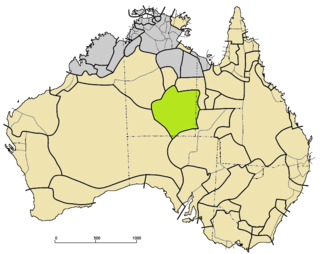
Dyirbal is an Australian Aboriginal language spoken in northeast Queensland by about 29 speakers of the Dyirbal tribe. It is a member of the small Dyirbalic branch of the Pama–Nyungan family. It possesses many outstanding features that have made it well known among linguists.
Guugu Yimithirr, also rendered Guugu Yimidhirr, Guguyimidjir, and many other spellings, is an Australian Aboriginal language, the traditional language of the Guugu Yimithirr people of Far North Queensland. It belongs to the Pama-Nyungan language family. Most of the speakers today live at the community of Hopevale, about 46 km from Cooktown. Guugu Yimithirr is one of the more famous Australian Aboriginal languages because it is the source language of the word "kangaroo."
The Wilson River language is an Australian Aboriginal language of the Karnic family. It was spoken by several peoples along the Wilson River in Queensland. Of these, the Wangkumara and Galali may have migrated from the Bulloo River and abandoned their language when they arrived.
Robert Malcolm Ward Dixon is a Professor of Linguistics in the College of Arts, Society, and Education and The Cairns Institute, James Cook University, Queensland. He is also Deputy Director of The Language and Culture Research Centre at JCU. Doctor of Letters, he was awarded a prestigious Honorary Doctor of Letters Honoris Causa by JCU in 2018. Fellow of British Academy; Fellow of the Australian Academy of the Humanities, and Honorary member of the Linguistic Society of America, he is one of three living linguists to be specifically mentioned in The Concise Oxford Dictionary of Linguistics by P. H. Matthews.
Awabakal is an Australian Aboriginal language that was spoken around Lake Macquarie and Newcastle in New South Wales. The name is derived from Awaba, which was the native name of the lake. It was spoken by Awabakal and Wonnarua peoples.

Yidiny is a nearly extinct Australian Aboriginal language, spoken by the Yidinji people of north-east Queensland.
The aversive or evitative case is a grammatical case found in Australian Aboriginal languages that indicates that the marked noun is avoided or feared.
Worimi, or Gadjang is an Australian Aboriginal language. It is the traditional language of the Worimi people, whose descendants now speak English.
The Barrow Point or Mutumui language, called Eibole, is a recently-extinct Australian Aboriginal language. According to Wurm and Hattori (1981), there was one speaker left at the time.
Ngardi (Ngarti) or Ngardilj, also called Bunara, is a moribund Australian Aboriginal language.
Diyari or Dieri is an Australian Aboriginal language of South Australia.
Kalkatungu is an extinct Australian Aboriginal language formerly spoken around the area of Mount Isa, Queensland.
Warluwarra is an extinct Australian Aboriginal language of Queensland.

Arrernte or Aranda or more specifically Upper Arrernte, is a dialect cluster spoken in and around Alice Springs in the Northern Territory, Australia. The name is sometimes spelled Arunta or Arrarnta.
Gunbarlang (Kunbarlang) is an Australian Aboriginal language in northern Australia with multiple dialects. Other names are Gungalang and Warlang. Speakers are multilingual in Gunwinygu and Mawng. Most of the Gunbarlang people now speak Gunwinygu.

Durubalic is a small family of extinct Australian Aboriginal languages of Queensland.

Daungwurrung is the extinct Indigenous Australian language being revived by the Taungurung people of the Kulin Nation of Central Victoria. Daungwurrung was spoken north of the Great Dividing Range in the Goulburn River Valley around Mansfield, Benalla and Heathcote.
Warrgamay is an extinct Australian Aboriginal language of northeast Queensland. It was closely related to Dyirbal.
Andjingith is an Aboriginal language once spoken in Cape York in Queensland.
The Madngella, otherwise known as the Matngala or Hermit Hill tribe, are an indigenous Australian people of the Northern Territory, Australia.






